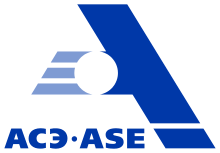Atomstroyexport
Atomstroyexport (Russian: Атомстройэкспорт) is the Russian Federation's nuclear power equipment and service exporter. It is a fully owned subsidiary of Rosatom.[2] The activities of Atomstroyexport are financially supported by the Russian government. The President of ASE Group of Companies is Alexander Lokshin.[3]
 | |
| Joint Stock Company | |
| Industry | Nuclear technology |
| Founded | 1973 |
| Headquarters | Moscow , Russia |
Key people | Alexander Lokshin |
| Products | Nuclear reactors |
| Services | Construction of nuclear power and research projects |
| Revenue | $1.82 billion[1] (2017) |
| -$18.3 million[1] (2017) | |
| Total assets | $4.36 billion[1] (2017) |
| Total equity | $673 million[1] (2017) |
| Owner | Rosatom (100%)[2] |
| Parent | Rosatom |
| Website | http://ase-ec.ru |
History
The first research reactor was built and launched in China now, in the "Institute of Nuclear Physics," in 1958. After two years in the city of Lanzhou to her it was erected a "Physical Institute". In it was an accelerator of the brand "U-150", specially built at the Izhorskiye Zavody for the Chinese (150 - is the diameter of the magnet poles in cm), the cyclotron, the deuteron has the energy of 18 MeV. The following year, the organization in the city of Rez (Czechoslovakia) is building "VVR-S", a research reactor (4 MW). In the Institute for Nuclear Research at Dresden, East Germany in 1960 it building a full range of physical and chemical laboratory, the cyclotron "U-120" research reactor "VVR-S" (power of 2 MW). In the same year in Yugoslavia organization (under the "Nuclear Research Center") built: a major scientific center named. Boris Kidridzha heavy water reactor (capacity up to 10 MW), radiochemical, and various other laboratories. After that, your own research reactor (2 MW) appears and Egypt - in 1961. At the same time near the Sophia, capital of Bulgaria was constructed "Institute of Nuclear Physics", which included were: Experimental Reactor type "IRT" and the radiochemical laboratory. And in 1962 "Institute for Nuclear Research" (with 2MW experimental reactors "VVR-S") appear in the Hungarian People's Republic and the Socialist Republic of Romania, respectively, in the cities of Debrecen and in Bucharest.
Recent period
The Russian nuclear vendor is building the first reactor power unit in Iranian Bushehr nuclear power plant located 400 kilometres (250 mi) southwest of Tehran under a US$1 billion contract signed in 1995. In 2007, AtomStroyExport signed a memorandum of understanding with Ciner Insaat Ticaret ve Sanayi to promote its VVER-design pressurized water reactors in Turkey. In Bangladesh, proposals have been prepared to resurrect the potential Rooppur nuclear power plant. In the UK, Atomstroyexport would consider partnering with a Western manufacturer for a new UK builder.[3] In Morocco, Atomstroyexport is considering participation in construction of a nuclear power plant at Sidi Boulbra.[4]
In late October 2006, the offer of Atomstroyexport for construction of the Belene Nuclear Power Plant in Bulgaria, using third-generation VVER-1000/V-446B reactors, was approved. The first unit would be in operation by 2013 and the second a year later.[5][6] On 28 March 2012 the Bulgarian government announced the withdrawal from the Belene project due to a negative report regarding the viability of the future power plant and the lack of another major European or American investor.
Between 1999 and 2007, Atomstroyexport constructed the Tianwan Nuclear Power Plant in China, which consists of two VVER reactors with 1,060 MW each, and has signed an agreement for construction of units 3 and 4. Unit 5 to 8 are firmly planned.[7]
On 19 February 2008, Atomstroyexport signed a cooperation agreement with Technopromexport, a Russian exporter of other large-scale power generation types, on the construction and management of power projects in Russia and abroad.[8]
On 14 December 2009, Atomstroyexport bought Nukem Technologies for 23.5 million Euros, adding nuclear power plant decommissioning, waste management and engineering services to its portfolio.[9]
Atomstroyexport will build 4 reactors in Ninh Thuận, Vietnam. The reactors are slated to open one each year from 2021–4. An 8 billion US$ loan has been extended by the Russian state.[10]
Other projects include Akkuyu NPP, Hanhikivi NPP, Koodankulam NPP and Mochovce NPP. See also VVER#Power plants.
References
- http://e-disclosure.ru/portal/files.aspx?id=36765&type=3.
- "Список аффилированных лиц". e-disclosure.ru. Retrieved 12 October 2018.
- "Russian push for new business continues". World Nuclear News. 2008-01-03. Archived from the original on 2008-05-09. Retrieved 2008-01-06.
- "Emerging Nuclear Energy Countries. Briefing Paper 102". World Nuclear Association. 2010-09-27. Retrieved 2010-10-10.
- Цанев, Белчо (2006-10-31). "Дадоха "Белене" на руснаците" (in Bulgarian). Standart News. Retrieved 2006-10-31.
- "Europe approves of Belene plan". World Nuclear News. 2007-12-10. Retrieved 2008-01-06.
- "Russia and China deal on uranium, enrichment and power". World Nuclear News. 2007-11-09. Archived from the original on 2007-11-16. Retrieved 2008-01-06.
- "Russian power giants join forces". World Nuclear News. 2008-02-21. Retrieved 2008-02-23.
- "Atomstroyexport buys NPP decommissioning technology". Kommersant. RIA Novosti. 2009-12-25. Archived from the original on 5 January 2010. Retrieved 2009-12-26.
- "Russia to grant $8 bln loan to Vietnam to build first nuke plant". RIA Novosti. 2011-11-23. Retrieved 2011-12-03.